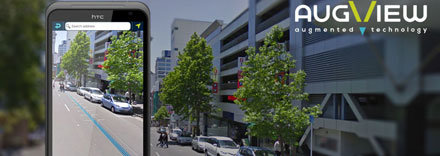
A Kiwi company is developing an augmented reality app to help utility companies manage their infrastructure, but also sees big possibilities for outdoor games and creative agencies.
Augview was developed for gas, electricity and water companies and their subcontractors to view and manage the increasingly dense network of pipes and cables under roads. It’s a mobile geographic information system (GIS) which also uses augmented reality so field workers can get a 3D-modelled view of infrastructure.
Workers can also take photos as they dig beneath streets, geotag them and link them to particular GPS coordinates.
The iOS, Android and Windows 8 app relies on a smartphone or tablet’s GPS, accelerometer and magnetometer to locate people and their movement in physical environments. The data is sourced from what asset owners publish online.
Augview CEO Mike Bundock has worked in the GIS industry for more than 30 years as a software developer and consultant. Early last year, while running his consultancy Spatial Information Systems, he saw an opportunity to create a protoype of the app.
“It dawned on me one day that these guys out in the field are still using spraycans and measuring tapes,” says Bundock. “I saw the same thing happening in Singapore. The guys that install and design and manage the teams that dig it all up, they don’t have very good tools at all.
“With tablets and smartphones these days, the devices have really good computing capability, they have 3G or 4G communications and very good screens and cameras, and sensors and GPS to know where you are.”
Bundock completed Growth Management’s Business Dominoes course to validate and develop his idea, forming Augview as a company and transferring the IP he developed under Spatial Information Systems.
Augview has secured seed funding from private investors and employed three developers. The app, developed using the Unity augmented reality platform, is globally scalable, says Bundock. That’s because outdated tools are a worldwide problem among utilities and telco workers and because the app can cater for the relatively small number of GIS products used worldwide to manage the companies’ assets.
Augview is now exploring the possibilities of the platform for creating games and promotions for advertisers. That would mean making virtual universes in outdoor spaces, says business development manager Melanie Langlotz.
It’s registered the Augview and Augvert trademarks as it develops these parts of the business. Interest has come from a company that wants to get people exercising with a game that sees people chasing virtual healthy food around a park.
The Otorohanga Kiwi House and Native Bird Park imagines an augmented reality-based park showcasing extinct birds, says Langlotz. Augview has already created a game that lets kids interact with virtual dinosaurs.
The app could also be used by architects to place models of houses on a side and use devices to virtually walk inside them, says Bundock.
The company charges $75 a month for Augview and so far has made sales in Australia and Malaysia. Some Kiwi utility companies are trialling it, Bundock says.




